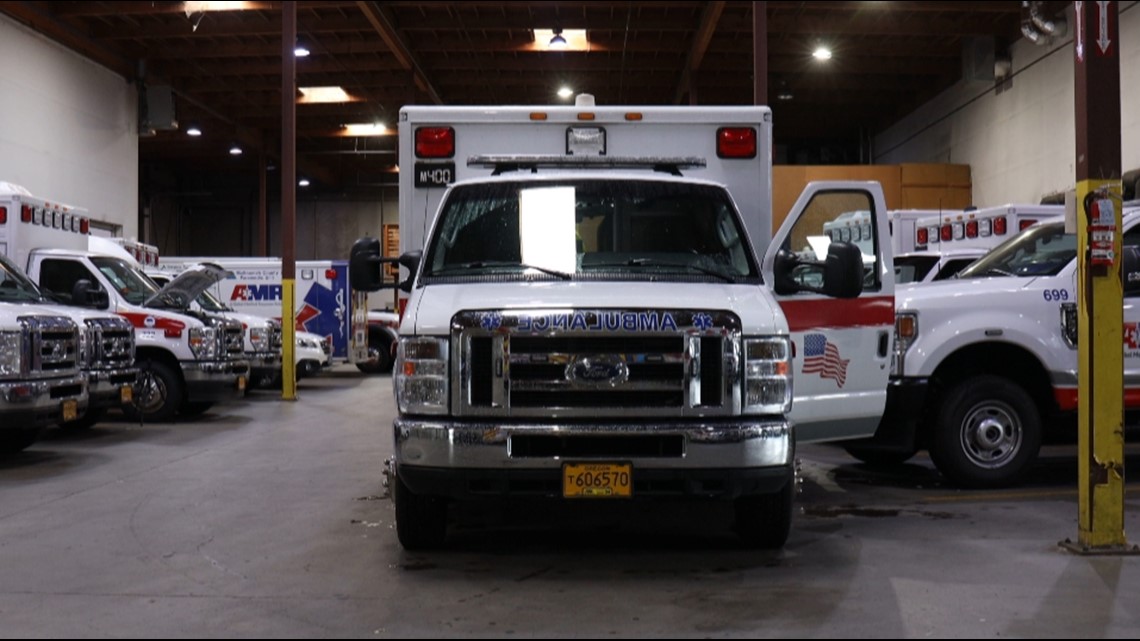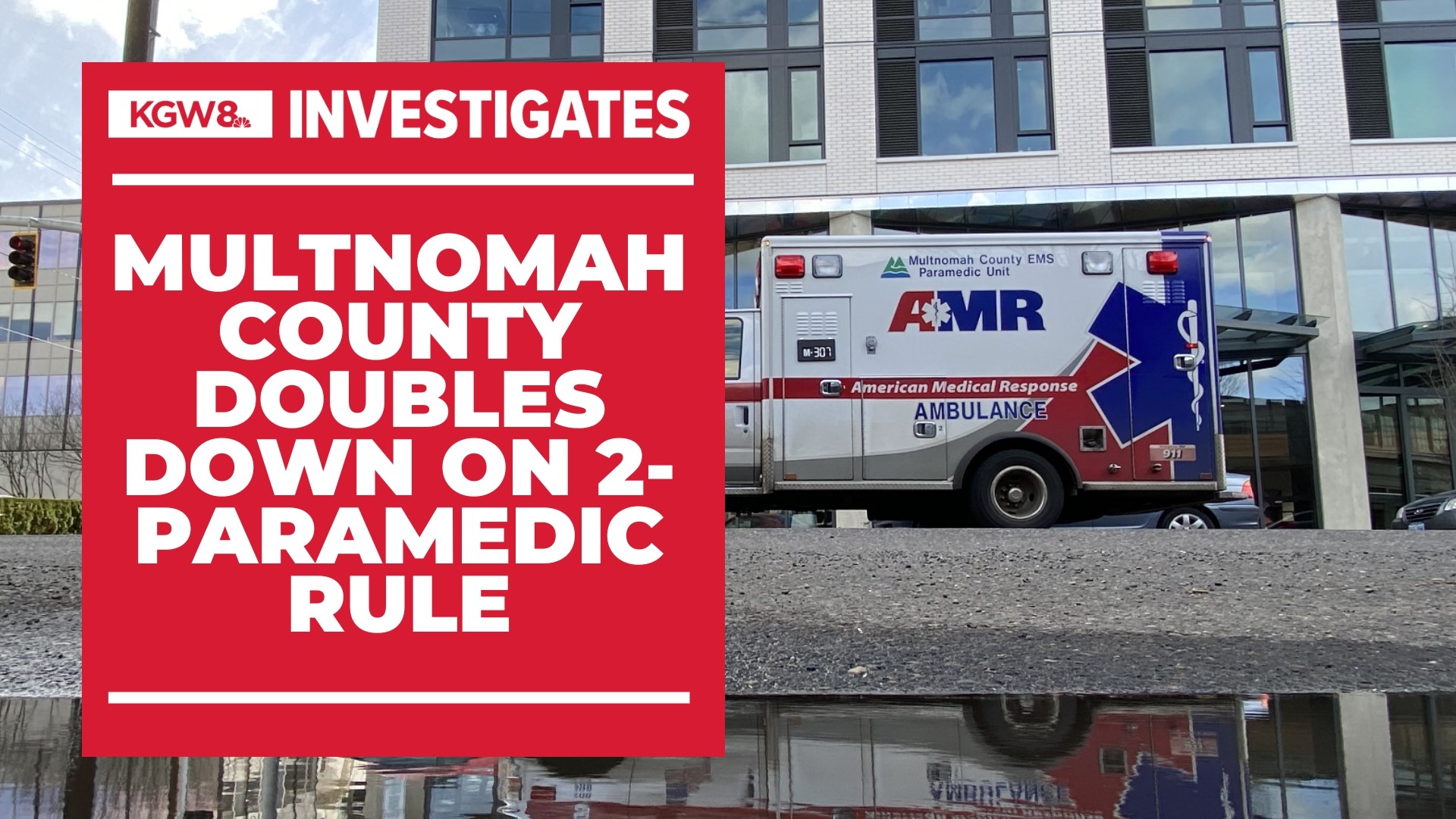PORTLAND, Ore. — In response to a formal request from ambulance provider American Medical Response (AMR) to loosen Multnomah County's staffing requirements, Chair Jessica Vega Pederson fired back Tuesday with her own four-point plan to address AMR's slow response times — accompanied by the looming threat of an additional $1.6 million in fines for AMR.
“I won't be bullied into any kind of quick fix," Vega Pederson said during a press conference on Tuesday. "And the truth is that AMR is failing our community. This company hasn't provided enough ambulance service for Multnomah County families for almost two years and at the same time they expanded into Washington County.”
Since, 2022 AMR has consistently failed to meet the standards for response times stipulated in its contract with the county, and 911 dispatchers frequently find themselves without any ambulances available to send out to emergency medical calls. The company has pointed to a nationwide shortage of medical responders — exacerbated, they say, by Multnomah County's requirement that ambulances be staffed by two paramedics, instead of the more common one-paramedic, one-EMT model.
But in a statement, Vega Pederson's office outlined its reasons for sticking with the two-paramedic model, some of which are unique to Multnomah County.
The national standard of care for medical emergencies is for at least two paramedics to respond, the county chair's office said. In neighboring Oregon counties where AMR operates using the one-and-one model, Multnomah County said that local fire departments are generally able to supply a second paramedic when responding to the same calls.
"In Multnomah County, because of the growing 911 call volume, fire agencies in 2023 were able to respond to just 75% of 911 medical calls that were ultimately found to be life-threatening," Vega Pederson's office said.
Notably, Portland Fire & Rescue has repeatedly said that it responds to all life-threatening 911 calls, adding at least one paramedic and other first responders to a scene for initial treatment. When explaining the 25% of calls that fire doesn't respond to, Vega Pederson referenced calls that escalate in severity after AMR paramedics or EMTs arrive.
Meanwhile, the county pointed out, AMR has struggled to adequately staff ambulances in Clackamas, Clark and now Washington County, despite the different model in place there. While response times are not quite as chronically poor in those counties, AMR also routinely fails to meet standards in each.
Vega Pederson's four-point plan
Multnomah County will start by moving into formal mediation with AMR to address the response time issue, Vega Pederson said. Since the company has failed to meet contractual obligations for its response times, the county will move to collect an additional $1.6 million in fines from AMR if the company doesn't come up with a "clear plan of action" to staff ambulances, which would bring the total fine to more than $2 million since August.
The county suggested that AMR should shore up staffing by subcontracting out to other ambulance providers, provide hiring and retention incentives, and fully staff the "Basic Life Support" ambulances that are supposed to provide an EMT-only response for less serious medical calls, which the county said AMR has thus far failed to do.
"AMR continues to propose changing the way we do business instead of taking the necessary steps to improve their service," Vega Pederson said. "I want to be clear: AMR's conduct in this crisis is irresponsible and unacceptable. They're allowing the crisis in our community to worsen so they can make more money instead of recruiting, hiring and retaining enough first responders on staff to provide the services that they've agreed to."
RELATED: Why isn't AMR working with Metro West to improve ambulance response times in Multnomah County?
Vega Pederson said she will also ask the board of commissioners to reopen the county's Ambulance Service Plan two years ahead of schedule, which is necessary in order to "make significant changes" and fully assess ambulance staffing.
Next, the county will ask the cities of Portland and Gresham to review their fire department services and figure out what it would take to meet AMR's proposed one-paramedic, one-EMT proposal — one which Vega Pederson's office said would necessitate more fire department responses to medical emergencies.
Finally, the county will convene its own experts and some from the Oregon Health Authority in the next 30 days to consult on the county's review of its Ambulance Service Plan, Vega Pederson's office said.


Pressure mounts on Multnomah County
While Vega Pederson appeared adamant Tuesday that Multnomah County won't lower its standards to suit AMR, the county increasingly stands alone.
AMR, Portland Fire & Rescue, the Gresham Fire Department, the Corbett Fire Department, several East County mayors, state lawmakers and others have asked Vega Pederson to loosen the two-paramedic requirement in hopes of getting more ambulances staffed.
"The status of transport ambulances in the City of Portland is critically insufficient," Portland Fire said in a statement following Vega Pederson's announcement Tuesday. "Portland Fire & Rescue encourages Multnomah County EMS to pilot a one-EMT and one-paramedic staffing model. In situations where AMR paramedics need more help, PF&R would continue to respond code 3 (with lights and sirens) to assist. All Portland Fire & Rescue Emergency Operations apparatus, including our two-person rescues, are staffed with a paramedic and carry lifesaving equipment to treat patients at any scene."
RELATED: Why ambulance provider AMR says Multnomah County's emergency medical system is in a state of crisis
Vega Pederson's office pointed out that the union representing AMR Multnomah County paramedics has argued in favor of retaining the two-paramedic standard, saying that it is “crucial for the safety and well-being of our community.”
County EMS Medical director Dr. Jon Jui has referenced a number of studies to support the idea that having two paramedics on a call results in better health outcomes, particularly for cardiac patients. Vega Pederson's office said that Multnomah County's cardiac arrest survival rates are in the top 10% nationally because of this model. However, opponents argue that having a somewhat less-qualified medical response is preferable to having a late response — or no response at all.
And according to Randy Lauer, AMR's vice president of operations, the solutions that Vega Pederson have proposed won't be sufficient. To the extent that they're possible, AMR is already pursuing them, he said.
AMR is fully sponsoring 32 EMTs to become paramedics, Lauer said, at a cost of about $17,000 each. Several more are awaiting admission, and the company expects the number of sponsored students to grow to more than 50 soon.
"All-in, that will represent an $850,000 investment, provided that we do not have to divert money to pay Multnomah fines," Lauer said in a statement.
But turnover remains a problem, one that Lauer said AMR can't solve with retention bonuses. Under Oregon law, the company would need to offer bonuses to each of its paramedics. For each paramedic to receive a "meaningful bonus," Lauer said it would cost the company about $3-5 million — something he said they can't afford.
Most paramedics who leave AMR end up working for a local fire department, Lauer said. With that being the case, he doesn't think some paramedics would be willing to accept a bonus that comes with an employment commitment.
"While we appreciate the Chair’s shout-out today to our paramedics, who have endured the pandemic and now face incredible fatigue due to the fact that we are unable to fully staff Multnomah County with dual medics, it only highlights the fact that her inaction has exacerbated the fatigue and burn out," Lauer said.
AMR released a statement following Vega Pederson's rejection of the company's proposal of a temporary staffing model switch, saying in part:
"A solution needs to be found through collaboration and understanding of the system; we are in crisis and the Chair is ignoring the facts. We need an actual plan that is attainable in the post-pandemic national paramedic shortage we find ourselves in. Assessing fines on AMR will not create paramedics. Our team is dedicated to finding serious solutions that will address this shortage and allow us to provide the timely and compassionate care the citizens of Multnomah County deserve."

